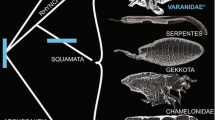Abstract
A braced framework of tubular struts, in the walls and air spaces of frog lungs, suspends the respiratory surface and holds the lung open at zero transmural pressure withstanding imploding forces created by abdominal viscera, much as would the supports of a bell tent. The struts are tubes, having a larger second moment of area than do solid struts of the same cross-sectional area, and so are stronger, and contain pulmonary vessels within a flexible wall. The orthogonal arrangement of the struts in the framework, explained in part by Maxwell’s Lemma and Michell’s Theorem, strengthens the framework and minimizes its weight; orthogonality is maintained as the lungs change size. A model is presented, in which a frog might control pre-and post-pulmonary vascular resistances and, hence, blood volume in the struts, without compromising pulmonary perfusion. Such adjustments could vary the area of lung and the extent of perfused capillaries exposed to pulmonary gas, helping match the lung’s surface area, weight and metabolic load to activity.
Similar content being viewed by others
References
Burggren, W. W. (1989). Lung structure and function: amphibians, in Comparative Pulmonary Physiology: Current Concepts, Vol. 39, Lung Biology in Health and Disease, S. C. Wood (Ed.), New York: Marcel Dekker, pp. 153–192.
Czopek, J. (1965). Quantitative studies on the morphology of respiratory surfaces in amphibians. Acta Anat. 62, 296–323.
de Jongh, H. J. and C. Gans (1969). On the mechanism of respiration in the bull frog Rana catesbeiana: a reassessment. J. Morph. 127, 259–290.
Gans, C. (1970). Strategy and sequence in the evolution of the external gas exchangers of ectothermal vertebrates. Forma et Functio. 3, 61–104.
Gaupp, E. (1904). Zur Lehre von dem Athmungsmechanismus beim Frosche. Arch. Anat. Physiol. Anat. Abt. 329–368.
Hillman, S. S. and P. C. Withers (1979). An analysis of respiratory surface area as a limit to activity metabolism in anurans. Can. J. Zool. 57, 2100–2105.
Holmgren, S. and G. Campbell (1978). Adenoreceptors in the lung of the toad, Bufo marinus: regional differences in response to amines and to sympathetic nerve stimulation. Comp. Biochem. Physiol. 60C, 11–18.
Hutchison, V. H., W. G. Whitford and M. A. Kohl (1968). The relation of body size and surface area to gas exchange in anurans. Physiol. Zool. 41, 65–85.
Konigstein, H. (1903). Zur Morphologie und Physiologie des Gefasssystems am Respirationstract. Z. Anat. Entwichlungsgesch. 1, 307–375.
Kuttner, (1874). Contribution on the arrangement of the circulation in the frog lung. Virchows Arch. 61, 21–43.
Lawry, J. V. and R. C. Drewes (1999). A diffusion column ventilates the lungs of resting frogs (in preparation).
Macintyre, D. H. and D. P. Toews (1976). The mechanics of lung ventilation and the effects of hypercapnia on respiration in Bufo marinus. Can. J. Zool. 54, 1364–1374.
Mania, J. N. (1989). The morphology of the lung of the East African tree frog Chiromantis petersi with observations on the skin and the buccal cavity as secondary gas exchange organs. A TEM and SEM study. J. Anat. 165, 29–34.
Maxwell, J. C. (1890). Scientific Papers, Vol. 2, C.U.P., pp. 175–177.
Michell, A. G. M. (1904). The limits of economy of materials in frame structures. Phil. Mag. 27, 8 No. 47, 589–597.
Okada, Y., S. Ishiko, S. Daido, J. Kim and S. Ikeda (1962). Comparative morphology of the lung with special reference to the alveolar epithelial cells. a. Lung of the amphibia. Acta Tuberc. Japan 11, 63–72.
Parkes, E. W. (1965). Braced Frameworks, Oxford: Pergamon Press.
Smith, D. G. and G. Campbell (1976). The anatomy of the pulmonary vascular bed in the toad Bufo marinus. Cell. Tissue Res. 165, 199–213.
Smith, D. G. and L. Rapson (1977). Differences in pulmonary microvascular anatomy between Bufo marinus and Xenopus laevis. Cell. Tissue Res. 178, 1–15.
Sprumont, P. (1969). Le relief intern du poumon de grenouille (Rana ridibunda). Acta Anat. 73, 315.
Tenney, S. M. and J. B. Tenney (1970). Quantitative morphology of cold-blooded lungs: amphibia and reptilia. Resp. Physiol. 9, 197–215.
West, N. H. and D. R. Jones (1975). Breathing movements in the frog, Rana pipiens: 1. the mechanical events associated with lung and buccal ventilation. Can. J. Zool. 53, 332–344.
Author information
Authors and Affiliations
Rights and permissions
About this article
Cite this article
Lawry, J. A hydrostatic Michell framework supports frog lungs. Bull. Math. Biol. 61, 683–700 (1999). https://doi.org/10.1006/bulm.1999.0104
Received:
Accepted:
Issue Date:
DOI: https://doi.org/10.1006/bulm.1999.0104




